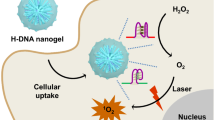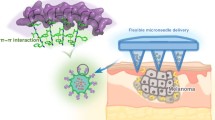Abstract
In this study, a networked swellable dextrin nanogel (DNG) was developed to achieve stimulated responsive small interfering RNA (siRNA) release for melanoma tumor therapy. siRNA was loaded into multidimensional dextrin nanogels by charge condensation with positive arginine residues modified in the dextrin backbone. Moreover, the networked nanogel was destroyed and loosened based on its bioreducible responsive property to control accelerated siRNA release in a bioreducible intracellular environment, while it remained stable under normal physiological conditions. We demonstrated that DNGs had swellable and disassembly properties under reduced buffer condition by transmission electron microscopy evaluation. The DNGs achieved an endosomal escape followed by selective release of the cargo into the cytosol by glutathione-triggered disassembly according to confocal microscopy observation. Thus, this smart nanogel achieved outstanding luciferase gene silencing efficiency and decreased Bcl2 protein expression in vitro and in vivo based on western blot analysis. Moreover, this nanogel exhibited superior anti-tumor activity for B16F10 xenograft tumors in C57BL/6 mice. These results demonstrate that the networked DNGs are effective for gene condensation and controlled intracellular release for tumor therapy. Overall, these findings suggest that this multidimensional swellable stimuli-responsive dextrin nanogel is an innovative strategy with great promise for gene and drug delivery.

Similar content being viewed by others
References
Whitehead, K. A.; Langer, R.; Anderson, D. G. Knocking down barriers: Advances in siRNA delivery. Nat. Rev. Drug Discov. 2009, 8, 129–138.
Oh, Y. K.; Park, T. G. siRNA delivery systems for cancer treatment. Adv. Drug Deliv. Rev. 2009, 61, 850–862.
Dominska, M.; Dykxhoorn, D. M. Breaking down the barriers: siRNA delivery and endosome escape. J. Cell Sci. 2010, 123, 1183–1189.
Wang, J.; Lu, Z.; Wientjes, M. G.; Au, J. L. S. Delivery of siRNA therapeutics: Barriers and carriers. AAPS J. 2010, 12, 492–503.
Brannon-Peppas, L.; Blanchette, J. O. Nanoparticle and targeted systems for cancer therapy. Adv. Drug Deliv. Rev. 2004, 56, 1649–1659.
Danhier, F.; Feron, O.; Préat, V. To exploit the tumor microenvironment: Passive and active tumor targeting of nanocarriers for anti-cancer drug delivery. J. Control. Release 2010, 148, 135–146.
Li, H. P.; Yuan, D. F.; Sun, M. J.; Ping, Q. N. Effect of ligand density and PEG modification on octreotide-targeted liposome via somatostatin receptor in vitro and in vivo. Drug Deliv. 2016, 23, 3562–3572.
Hillaireau, H.; Couvreur, P. Nanocarriers’ entry into the cell: Relevance to drug delivery. Cell. Mol. Life Sci. 2009, 66, 2873–2896.
Varkouhi, A. K.; Scholte, M.; Storm, G.; Haisma, H. J. Endosomal escape pathways for delivery of biologicals. J. Control. Release 2011, 151, 220–228.
Zhang, X. J.; Achazi, K.; Haag, R. Boronate cross-linked ATP- and pH-responsive nanogels for intracellular delivery of anticancer drugs. Adv. Healthc. Mater. 2015, 4, 585–592.
Boussif, O.; Lezoualc’h, F.; Zanta, M. A.; Mergny, M. D.; Scherman, D.; Demeneix, B.; Behr, J. P. A versatile vector for gene and oligonucleotide transfer into cells in culture and in vivo: Polyethylenimine. Proc. Natl. Acad. Sci. USA 1995, 92, 7297–7301.
Akinc, A.; Thomas, M.; Klibanov, A. M.; Langer, R. Exploring polyethylenimine-mediated DNA transfection and the proton sponge hypothesis. J. Gene Med. 2005, 7, 657–663.
Wu, J.; Zhao, L. L.; Xu, X. D.; Bertrand, N.; Choi, W. I.; Yameen, B.; Shi, J. J.; Shah, V.; Mulvale, M.; MacLean, J. L. et al. Hydrophobic cysteine poly(disulfide)-based redoxhypersensitive nanoparticle platform for cancer theranostics. Angew. Chem., Int. Ed. 2015, 54, 9218–9223.
Godbey, W. T.; Wu, K. K.; Mikos, A. G. Poly(ethylenimine) and its role in gene delivery. J. Control. Release 1999, 60, 149–160.
Cheng, R.; Feng, F.; Meng, F. H.; Deng, C.; Feijen, J.; Zhong, Z. Y. Glutathione-responsive nano-vehicles as a promising platform for targeted intracellular drug and gene delivery. J. Control. Release 2011, 152, 2–12.
Franco, R.; Cidlowski, J. A. Apoptosis and glutathione: Beyond an antioxidant. Cell Death Differ. 2009, 16, 1303–1314.
Mitchell, J. B.; Russo, A. The role of glutathione in radiation and drug induced cytotoxicity. Br. J. Cancer Suppl. 1987, 8, 96–104.
Russo, A.; De Graff, W.; Friedman, N.; Mitchell, J. B. Selective modulation of glutathione levels in human normal versus tumor cells and subsequent differential response to chemotherapy drugs. Cancer Res. 1986, 46, 2845–2848.
Sasaki, Y.; Akiyoshi, K. Nanogel engineering for new nanobiomaterials: From chaperoning engineering to biomedical applications. Chem. Rec. 2010, 10, 366–376.
Hamidi, M.; Azadi, A.; Rafiei, P. Hydrogel nanoparticles in drug delivery. Adv. Drug Deliv. Rev. 2008, 60, 1638–1649.
Sisson, A. L.; Steinhilber, D.; Rossow, T.; Welker, P.; Licha, K.; Haag, R. Biocompatible functionalized polyglycerol microgels with cell penetrating properties. Angew. Chem., Int. Ed. 2009, 48, 7540–7545.
Seiffert, S. Small but smart: Sensitive microgel capsules. Angew. Chem., Int. Ed. 2013, 52, 11462–11468.
Oh, J. K.; Lee, D. I.; Park, J. M. Biopolymer-based microgels/nanogels for drug delivery applications. Prog. Polym. Sci. 2009, 34, 1261–1282.
Sahiner, N.; Godbey, W. T.; Mcpherson, G. L.; John, V. T. Microgel, nanogel and hydrogel–hydrogel semi-IPN composites for biomedical applications: Synthesis and characterization. Colloid Polym. Sci. 2006, 284, 1121–1129.
Kabanov, A. V.; Vinogradov, S. V. Nanogels as pharmaceutical carriers: Finite networks of infinite capabilities. Angew. Chem., Int. Ed. 2009, 48, 5418–5429.
Raemdonck, K.; Demeester, J.; De Smedt, S. Advanced nanogel engineering for drug delivery. Soft Matter 2009, 5, 707–715.
He, J.; Yan, B.; Tremblay, L.; Zhao, Y. Both core- and shell-cross-linked nanogels: Photoinduced size change, intraparticle LCST, and interparticle UCST thermal behaviors. Langmuir 2011, 27, 436–444.
Klinger, D.; Landfester, K. Dual stimuli-responsive poly(2-hydroxyethyl methacrylate-co-methacrylic acid) microgels based on photo-cleavable cross-linkers: pH-dependent swelling and light-induced degradation. Macromolecules 2011, 44, 9758–9772.
Wang, Y. C.; Wu, J.; Li, Y.; Du, J. Z.; Yuan, Y. Y.; Wang, J. Engineering nanoscopic hydrogels via photo-crosslinking salt-induced polymer assembly for targeted drug delivery. Chem. Commun. 2010, 46, 3520–3522.
Zhuang, J. M.; Jiwpanich, S.; Deepak, V. D.; Thayumanavan, S. Facile preparation of nanogels using activated ester containing polymers. ACS Macro Lett. 2012, 1, 175–179.
Li, Y. L.; Zhu, L.; Liu, Z. Z.; Cheng, R.; Meng, F. H.; Cui, J. H.; Ji, S. J.; Zhong, Z. Y. Reversibly stabilized multifunctional dextran nanoparticles efficiently deliver doxorubicin into the nuclei of cancer cells. Angew. Chem., Int. Ed. 2009, 48, 9914–9918.
Zhang, X. J.; Achazi, K.; Steinhilber, D.; Kratz, F.; Dernedde, J.; Haag, R. A facile approach for dual-responsive prodrug nanogels based on dendritic polyglycerols with minimal leaching. J. Control. Release 2014, 174, 209–216.
Gonçalves, C.; Torrado, E.; Martins, T.; Pereira, P.; Pedrosa, J.; Gama, M. Dextrin nanoparticles: Studies on the interaction with murine macrophages and blood clearance. Colloids Surf. B: Biointerfaces 2010, 75, 483–489.
Carvalho, V.; Castanheira, P.; Faria, T. Q.; Gonçalves, C.; Madureira, P.; Faro, C.; Domingues, L.; Brito, R. M. M.; Vilanova, M.; Gama, M. Biological activity of heterologous murine interleukin-10 and preliminary studies on the use of a dextrin nanogel as a delivery system. Int. J. Pharm. 2010, 400, 234–242.
Das, D.; Das, R.; Ghosh, P.; Dhara, S.; Panda, A. B.; Pal, S. Dextrin cross linked with poly(HEMA): A novel hydrogel for colon specific delivery of ornidazole. RSC Adv. 2013, 3, 25340–25350.
Das, D.; Patra, P.; Ghosh, P.; Rameshbabu, A. P.; Dhara, S.; Pal, S. Dextrin and poly(lactide)-based biocompatible and biodegradable nanogel for cancer targeted delivery of doxorubicin hydrochloride. Polym. Chem. 2016, 7, 2965–2975.
Molinos, M.; Carvalho, V.; Silva, D. M.; Gama, F. M. Development of a hybrid dextrin hydrogel encapsulating dextrin nanogel as protein delivery system. Biomacromolecules 2012, 13, 517–527.
Manchun, S.; Cheewatanakornkool, K.; Dass, C. R.; Sriamornsak, P. Novel pH-responsive dextrin nanogels for doxorubicin delivery to cancer cells with reduced cytotoxicity to cardiomyocytes and stem cells. Carbohydr. Polym. 2014, 114, 78–86.
Sedlak, J.; Lindsay, R. H. Estimation of total, protein-bound, and nonprotein sulfhydryl groups in tissue with Ellman’s reagent. Anal. Biochem. 1968, 25, 192–205.
Gilboe, D. D.; Willams, J. N., Jr. Evaluation of the Sakaguchi reaction for quanitative determination of arginine. Exp. Biol. Med. 1956, 91, 535–536.
Lee, S. J.; Huh, M. S.; Lee, S. Y.; Min, S.; Lee, S.; Koo, H.; Chu, J. U.; Lee, K. E.; Jeon, H.; Choi, Y. et al. Tumorhoming poly-siRNA/glycol chitosan self-cross-linked nanoparticles for systemic siRNA delivery in cancer treatment. Angew. Chem., Int. Ed. 2012, 51, 7203–7207.
Xie, Y.; Qiao, H. Z.; Su, Z. G.; Chen, M. L.; Ping, Q. N.; Sun, M. J. PEGylated carboxymethyl chitosan/calcium phosphate hybrid anionic nanoparticles mediated hTERT siRNA delivery for anticancer therapy. Biomaterials 2014, 35, 7978–7991.
Wong, C.; Stylianopoulos, T.; Cui, J. A.; Martin, J.; Chauhan, V. P.; Jiang, W.; Popovic, Z.; Jain, R. K.; Bawendi, M. G.; Fukumura, D. Multistage nanoparticle delivery system for deep penetration into tumor tissue. Proc. Natl. Acad. Sci. USA 2011, 108, 2426–2431.
Peer, D.; Karp, J. M.; Hong, S.; Farokhzad, O. C.; Margalit, R.; Langer, R. Nanocarriers as an emerging platform for cancer therapy. Nat. Nanotechnol. 2007, 2, 751–760.
Adams, J. M.; Cory, S. The Bcl-2 protein family: Arbiters of cell survival. Science 1998, 281, 1322–1326.
Acknowledgments
This work was financially supported by the National Science and Technology Major Project (No. 2017YFA0205400), the National Natural Science Foundation of China (Nos. 81373983 and 81573377), the Jiangsu Fund for Distinguished Youth (No. BK20170028) and the Natural Science Foundation of Jiangsu Province (No. BK20141352). The authors also acknowledged Dr. Maoshen Jie (Roquette Ltd., Shanghai, China) for his kind help in providing dextrin.
Author information
Authors and Affiliations
Corresponding author
Electronic supplementary material
Rights and permissions
About this article
Cite this article
Li, H., Zhou, Z., Zhang, F. et al. A networked swellable dextrin nanogels loading Bcl2 siRNA for melanoma tumor therapy. Nano Res. 11, 4627–4642 (2018). https://doi.org/10.1007/s12274-018-2044-6
Received:
Revised:
Accepted:
Published:
Issue Date:
DOI: https://doi.org/10.1007/s12274-018-2044-6




